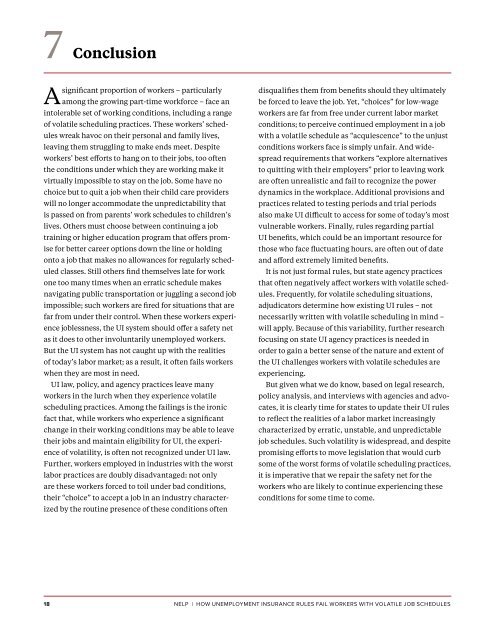Out of Sync
Out-of-Sync-Report
Out-of-Sync-Report
- No tags were found...
You also want an ePaper? Increase the reach of your titles
YUMPU automatically turns print PDFs into web optimized ePapers that Google loves.
7 Conclusionsignificant proportion <strong>of</strong> workers – particularlyA among the growing part-time workforce – face anintolerable set <strong>of</strong> working conditions, including a range<strong>of</strong> volatile scheduling practices. These workers’ scheduleswreak havoc on their personal and family lives,leaving them struggling to make ends meet. Despiteworkers’ best efforts to hang on to their jobs, too <strong>of</strong>tenthe conditions under which they are working make itvirtually impossible to stay on the job. Some have nochoice but to quit a job when their child care providerswill no longer accommodate the unpredictability thatis passed on from parents’ work schedules to children’slives. Others must choose between continuing a jobtraining or higher education program that <strong>of</strong>fers promisefor better career options down the line or holdingonto a job that makes no allowances for regularly scheduledclasses. Still others find themselves late for workone too many times when an erratic schedule makesnavigating public transportation or juggling a second jobimpossible; such workers are fired for situations that arefar from under their control. When these workers experiencejoblessness, the UI system should <strong>of</strong>fer a safety netas it does to other involuntarily unemployed workers.But the UI system has not caught up with the realities<strong>of</strong> today’s labor market; as a result, it <strong>of</strong>ten fails workerswhen they are most in need.UI law, policy, and agency practices leave manyworkers in the lurch when they experience volatilescheduling practices. Among the failings is the ironicfact that, while workers who experience a significantchange in their working conditions may be able to leavetheir jobs and maintain eligibility for UI, the experience<strong>of</strong> volatility, is <strong>of</strong>ten not recognized under UI law.Further, workers employed in industries with the worstlabor practices are doubly disadvantaged: not onlyare these workers forced to toil under bad conditions,their “choice” to accept a job in an industry characterizedby the routine presence <strong>of</strong> these conditions <strong>of</strong>tendisqualifies them from benefits should they ultimatelybe forced to leave the job. Yet, “choices” for low-wageworkers are far from free under current labor marketconditions; to perceive continued employment in a jobwith a volatile schedule as “acquiescence” to the unjustconditions workers face is simply unfair. And widespreadrequirements that workers “explore alternativesto quitting with their employers” prior to leaving workare <strong>of</strong>ten unrealistic and fail to recognize the powerdynamics in the workplace. Additional provisions andpractices related to testing periods and trial periodsalso make UI difficult to access for some <strong>of</strong> today’s mostvulnerable workers. Finally, rules regarding partialUI benefits, which could be an important resource forthose who face fluctuating hours, are <strong>of</strong>ten out <strong>of</strong> dateand afford extremely limited benefits.It is not just formal rules, but state agency practicesthat <strong>of</strong>ten negatively affect workers with volatile schedules.Frequently, for volatile scheduling situations,adjudicators determine how existing UI rules – notnecessarily written with volatile scheduling in mind –will apply. Because <strong>of</strong> this variability, further researchfocusing on state UI agency practices is needed inorder to gain a better sense <strong>of</strong> the nature and extent <strong>of</strong>the UI challenges workers with volatile schedules areexperiencing.But given what we do know, based on legal research,policy analysis, and interviews with agencies and advocates,it is clearly time for states to update their UI rulesto reflect the realities <strong>of</strong> a labor market increasinglycharacterized by erratic, unstable, and unpredictablejob schedules. Such volatility is widespread, and despitepromising efforts to move legislation that would curbsome <strong>of</strong> the worst forms <strong>of</strong> volatile scheduling practices,it is imperative that we repair the safety net for theworkers who are likely to continue experiencing theseconditions for some time to come.18 NELP | HOW UNEMPLOYMENT INSURANCE RULES FAIL WORKERS WITH VOLATILE JOB SCHEDULES


